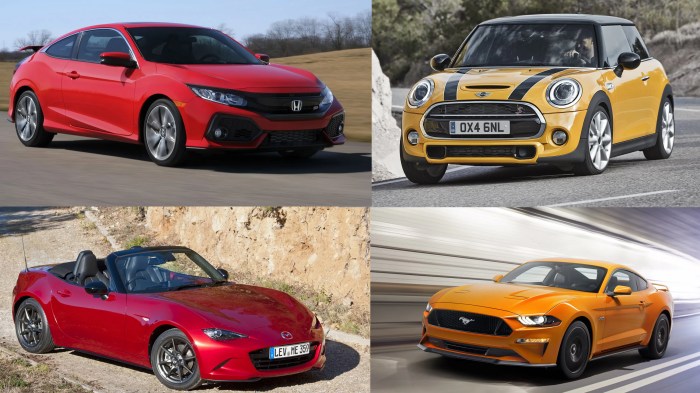Best New Car Low Price Finding Your Ideal Ride
Defining “Best” and “Low Price”
Best new car low price – Determining the “best” low-priced new car requires a nuanced approach, going beyond simply the sticker price. “Low price” itself is relative and depends on market conditions and individual budgets. We’ll explore a range of price points generally considered affordable, along with key factors beyond price that contribute to a car’s overall value.
Price Range Considerations
Generally, a new car priced under $25,000 could be considered low-priced in many markets. However, this range can vary significantly depending on location, vehicle type, and features. Prices below $20,000 often represent entry-level models with more basic features, while those in the $20,000-$25,000 bracket might offer more amenities and advanced safety technologies.
Factors Beyond Price
Several factors significantly influence a car’s value proposition beyond its initial cost. Safety ratings, as measured by organizations like the IIHS and NHTSA, are crucial for assessing a vehicle’s ability to protect occupants in accidents. Fuel efficiency, measured in miles per gallon (MPG), directly impacts long-term running costs. Reliability, often assessed through surveys and reports from organizations like Consumer Reports, indicates the likelihood of experiencing mechanical problems over time.
Value Ranking Methodologies

Source: topspeed.com
Various methodologies exist for ranking cars based on value. Some prioritize fuel efficiency and safety, while others weigh reliability and maintenance costs more heavily. Websites and publications often use proprietary algorithms combining several factors to generate overall value scores. Direct comparisons of specifications and features across models remain a valuable method for individual assessment.
Identifying Top Contenders in the Low-Price New Car Market
Several car models consistently stand out for offering a good balance of affordability and desirable features. The following table provides a snapshot of some top contenders, categorized by vehicle type. Note that starting prices can vary based on trim level and options.
Top Contenders Table

Source: autotrader.com
| Make | Model | Starting Price (USD, approximate) | Key Features |
|---|---|---|---|
| Honda | Civic | $23,000 | Fuel efficiency, reliable engine, spacious interior, good safety ratings |
| Toyota | Corolla | $21,000 | Exceptional reliability, fuel efficiency, comfortable ride, standard safety features |
| Kia | Rio | $16,000 | Affordable price point, decent fuel economy, standard infotainment features |
| Hyundai | Accent | $17,000 | Budget-friendly, good fuel economy, basic but functional features |
| Nissan | Sentra | $20,000 | Comfortable ride, decent fuel economy, available advanced safety features |
Model Strengths and Weaknesses
Each model offers a unique blend of advantages and disadvantages. The Honda Civic, for example, is renowned for its reliability and fuel efficiency but might lack some of the advanced tech features found in more expensive competitors. The Kia Rio’s affordability is a significant draw, but its interior might feel less refined than some rivals. A thorough evaluation of individual needs and preferences is crucial when comparing these models.
Factors Influencing Affordability: Best New Car Low Price
Several factors beyond the sticker price significantly impact a car’s overall affordability. Fuel economy, financing options, and hidden costs all play a role in the total cost of ownership.
Fuel Economy’s Impact
Higher fuel efficiency translates to lower running costs over the car’s lifespan. A vehicle with superior MPG will require less frequent fuel purchases, resulting in considerable savings, especially for drivers with higher annual mileage.
Financing Options
Financing options, such as loans and leases, can influence affordability. Longer loan terms result in lower monthly payments but higher overall interest paid. Leases typically involve lower monthly payments than loans but require returning the vehicle at the end of the lease term.
Hidden Costs
Beyond the purchase price, several hidden costs must be considered. These include taxes, registration fees, insurance premiums, and potential maintenance expenses. Accurate budgeting for these additional costs is crucial for responsible car ownership.
Assessing Reliability and Safety
Reliability and safety are paramount when choosing a vehicle. Both contribute significantly to long-term affordability by minimizing unexpected repair costs and protecting occupants in potential accidents.
Safety Ratings Comparison
- Honda Civic: Typically receives high safety ratings from IIHS and NHTSA.
- Toyota Corolla: Consistently scores well in safety tests, often achieving top safety pick awards.
- Kia Rio: Offers a good suite of standard safety features but may not achieve the highest ratings in all crash tests.
- Hyundai Accent: Provides essential safety features but may not match the higher-rated competitors in all aspects.
- Nissan Sentra: Offers a range of safety features, with higher trim levels generally scoring better in safety tests.
Reliability Comparison
A comparative chart showing reliability data for these models would ideally incorporate data from sources like Consumer Reports, J.D. Power, and other reputable automotive reliability studies. This chart would visually compare predicted repair frequency and costs for each model over a set period, such as five years.
Warranty Coverage
Warranty coverage significantly impacts long-term affordability by protecting against unexpected repair costs during the warranty period. Extended warranties, while adding to the initial cost, can provide added peace of mind and potentially reduce future expenses.
Features and Technology
Even in budget-friendly vehicles, manufacturers strive to include essential features and increasingly, advanced technologies.
Standard Features
Standard features in most affordable new cars typically include basic infotainment systems with Bluetooth connectivity, power windows and locks, air conditioning, and a range of safety features like anti-lock brakes (ABS) and electronic stability control (ESC).
ADAS Availability
Advanced Driver-Assistance Systems (ADAS) are becoming increasingly common, even in lower-priced vehicles. Features like lane departure warnings, automatic emergency braking, and adaptive cruise control are enhancing safety and convenience in budget-friendly models.
Infotainment Systems

Source: motor1.com
Finding the best new car at a low price requires careful research. A popular option to consider within this segment is the scorpio car price new model , which often offers competitive pricing. Ultimately, the ideal choice depends on individual needs and preferences, but exploring various models is key to securing the best value for your money.
Infotainment systems in affordable cars are generally simpler than those in luxury vehicles. However, most offer touchscreen interfaces, smartphone integration (Apple CarPlay and Android Auto), and basic audio capabilities. Screen size and user interface design vary significantly across models.
Visual Representation of Key Data
Visual aids can effectively communicate complex data. A bar chart illustrating the relationship between price and fuel efficiency, along with a description of a hypothetical ideal low-priced car and an explanation of how design affects price, can enhance understanding.
Price vs. Fuel Efficiency Bar Chart
A bar chart showing the relationship between starting price and combined MPG (city and highway) for the five models listed earlier would visually represent the trade-off between affordability and fuel efficiency. Models with lower prices might show lower MPG, while some models might offer a balance of both. The chart would clearly label each bar with the model name, price, and MPG, making the comparison easy to understand.
Hypothetical Ideal Low-Priced Car, Best new car low price
An ideal low-priced car would be compact but spacious, offering a comfortable ride with good visibility. It would boast a fuel-efficient engine, high safety ratings, and a user-friendly infotainment system with essential features. The exterior design would be modern and appealing without extravagant or costly embellishments.
Design and Price Relationship
Design elements significantly impact a car’s price. Larger vehicles generally cost more due to increased material usage. Complex body designs with numerous curves and angles can be more expensive to manufacture. The use of premium materials in the interior also adds to the overall cost. Simpler, more streamlined designs often lead to lower manufacturing costs and thus more affordable vehicles.
Essential Questionnaire
What are the typical warranties offered on low-priced new cars?
Warranties vary by manufacturer and model, but generally, you can expect a basic powertrain warranty (covering the engine, transmission, and drivetrain) of 3-5 years or a certain mileage limit. Bumper-to-bumper warranties are usually shorter, often 3 years or 36,000 miles.
How much should I budget for insurance on a low-priced new car?
Insurance costs depend on several factors, including your driving record, location, and the car’s safety features. However, generally, insurance for a less expensive car will be cheaper than for a luxury vehicle. It’s best to get quotes from multiple insurers to compare prices.
Can I negotiate the price of a new car, even if it’s already considered low-priced?
Yes, negotiation is always possible. While the starting price might be fixed, you can still try to negotiate on additional fees, such as dealer prep charges or extended warranties. Researching the market price and knowing your budget beforehand will strengthen your negotiating position.





















